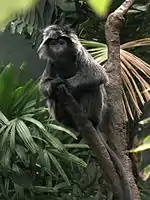Mount Halimun Salak National Park
Mount Halimun Salak National Park is a 400 km2 conservation area in the Indonesian province of West Java on the island of Java. Established in 1992, the park comprises two mountains, Mount Salak and Mount Halimun with an 11-kilometer forest corridor.[2][3] It is located near the better known Mount Gede Pangrango National Park, but the national park should be accessed from Sukabumi, 2 hours drive to the administration post and then 2 hours drive (30 kilometers) again to Cikaniki post gate.
| Mount Halimun Salak National Park | |
|---|---|
| Taman Nasional Gunung Halimun Salak | |
IUCN category II (national park) | |
 View of Mount Salak from a rocky river bed (c. 1920). | |
 Mount Halimun Salak NP Location in Java | |
| Location | West Java, Indonesia |
| Nearest city | Sukabumi |
| Coordinates | 6°48′S 106°29′E |
| Area | 40,000 hectares (99,000 acres; 400 km2) |
| Established | February 28, 1992 |
| Visitors | 7,000 (in 2006[1]) |
| Governing body | Ministry of Environment and Forestry |
| Website | halimunsalak.org |
The park contains water catchment areas shielded from urban populations and agricultural areas to the north,[4] as well as several endangered animals and rare birds.[5]
Geography
Its mountain tops reach 1,929 metres and are often mist-shrouded, while its valleys are thought to hide much that remains to be discovered.[4] Mount Salak is a critical water catchment area for its very high rainfall.[6] The park is an amalgamation of two important ecosystems at Halimun and Mount Salak, which are connected by an 11-kilometer forest corridor.[7]
Communities in the park
The Kesepuhan traditional community is a group of around 5,300 people who live in the southern part of the park. Their main village is Ciptagelar.[8]
Ecology

The lower zones hold secure populations of the endangered West Javan gibbon (Hylobates moloch moloch) - a sub-species of the silvery gibbon. Mount Halimun is its most secure habitat, but its range is restricted to a thin ring around the park as the species is not found above 1,200 metres.[4] Javan lutung (Trachypithecus auratus), and other endemic species are evident; about half its 145 known bird species are rarely seen elsewhere in Java.[4]
Chevron Pacific Indonesia which has 10,000 hectares geothermal concession, used 3 percent of its area for its power station facilities, has been involved in some conservation activities such as set camera traps.[3][9]
3 animals are known to breed:[3]
- Silvery gibbon rose from 54 in 2008 to 61 in 2013
- Javan hawk eagle rose from 10 in 2008 to 16 in 2011, but declined to 11 in 2013
- Javan leopard rose significantly from 6 in 2008 to 18 in mid-2014
References
- Taman Nasional Gunung Halimun Salak: Visitor Information, (in Indonesian) retrieved 18 May 2010
- Whitten, Anthony J.; Whitten, Tony; Soeriaatmadja, Roehayat Emon; Suraya A. Afiff (1997-07-15). The ecology of Java and Bali. Oxford University Press. p. 213. ISBN 978-962-593-072-5. Retrieved 17 May 2010.
- Hans David Tampubolon (July 8, 2013). "Hidden cameras capture endangered species".
- Whitten, Tony and Jane (1992). Wild Indonesia: The Wildlife and Scenery of the Indonesian Archipelago. United Kingdom: New Holland. pp. 128–131. ISBN 1-85368-128-8.
- "Taman Nasional Gunung Halimun Salak (TNGHS)" (in Indonesian). Gunung Halimun Salak National Park Management Project. Archived from the original on 13 March 2004. Retrieved 17 May 2010.
- Foundation, Raptor Research (2003-01-01). The Journal of raptor research. Allen Press. Retrieved 17 May 2010.
- Ika Krismantari, 'Saving "THE CORRIDOR" ', The Jakarta Post, 8 May 2012.
- J. Adiguna, 'Living in harmony with the nature' Archived 2014-05-14 at the Wayback Machine, The Jakarta Post, 11 August 2008.
- CSR Outreach: Chevron restores ecology in Mt. Halimun Salak, 24 July 2012, The Jakarta Post.
External links
- Whitten, Tony and Jane (1992). Wild Indonesia: The Wildlife and Scenery of the Indonesian Archipelago. United Kingdom: New Holland. pp. 128–131. ISBN 1-85368-128-8.
- Mount Halimun Salak National Park Official Website
![]() Media related to Mount Halimun Salak National Park at Wikimedia Commons
Media related to Mount Halimun Salak National Park at Wikimedia Commons